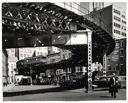Andreas Feininger
American
(1906 - 1999)
Andreas Feininger was born in Paris on December 27, 1906; the son of the internationally known American artist, Lyonel Feininger, and his second wife, Julia Berg. After graduating from the Bauhaus with a degree in Architecture in 1925, Feininger began working as an architect first in Dessau and finally in Hamburg. In 1932 he was fired from his job in Hamburg because of the rising tide of German nationalism that eventually gave way to the Nazi regime.
Unable to legally hold a job in Germany, Feininger, with assistance from his father’s former colleague Walter Gropius, found a job in Paris working for LeCorbusier. This position lasted only 9 months, however during that time in Paris he began courting Gertrude Wysse Hagg, who he would marry in 1933 in Sweden. While in Sweden, Feininger focused on developing prefabricated houses, an endeavor that would unceremoniously fail. The limitations to his architectural career forced him to explore new avenues for employment; including that of a free-lance architectural photographer. By 1939 he had produced three sizable photography books dealing with photography techniques, artful figural compositions and vistas of Stockholm. These were the first in a remarkable number of over 40 photography books (published between 1936 and 1984) that documented both his work and his revolutionary techniques such as solarization and reticulation. Unfortunately, the tide of anti-immigrant nationalism eventually washed over Sweden, and by December of 1939 Andreas and Wysse embarked for the haven of New York City.
Andreas’s first views of the city were ones of teeming chaos; of the city as a “whole organism”. These first impressions left an indelible imprint on his mind and directly influenced his approach to photographing urban landscape. Within his first year of living in New York City, Feininger had found work as a freelance filer with Life magazine, and his occasional relationship with the publication graduated to a full-time position in 1943.
As part of the capable stable of talented Life photographers, Feininger was able to focus specifically on the distant formalized views of America’s major cities, while simultaneously capturing the rapidly changing landscape. The restrictions placed on his private endeavors by Life magazine eventually necessitated their professional separation, however, and by 1962 Feininger found himself able to devote all of his energies to authoring and editing photography books, which he did until his death in 1999.
Joel Smith, Andreas Feininger, Vassar College: Poughkeepsie, NY, 2003. 11 Miriam Berkley, “The Quiet Man”, American Photographer, Vol.18 No.3 (March 1987), 55. Introduction to Feininger at the George Eastman House, http://www.geh.org/fm/feininger/htmlsrc/feinintro.html Andreas Feininger, Andreas Feininger, Morgan and Morgan: Dobbs Ferry, NY, 1973. 151. Berkley, “The Quiet Man”, 56. Smith, 15 Ibid, 15-17.
SM 09/09
American
(1906 - 1999)
Andreas Feininger was born in Paris on December 27, 1906; the son of the internationally known American artist, Lyonel Feininger, and his second wife, Julia Berg. After graduating from the Bauhaus with a degree in Architecture in 1925, Feininger began working as an architect first in Dessau and finally in Hamburg. In 1932 he was fired from his job in Hamburg because of the rising tide of German nationalism that eventually gave way to the Nazi regime.
Unable to legally hold a job in Germany, Feininger, with assistance from his father’s former colleague Walter Gropius, found a job in Paris working for LeCorbusier. This position lasted only 9 months, however during that time in Paris he began courting Gertrude Wysse Hagg, who he would marry in 1933 in Sweden. While in Sweden, Feininger focused on developing prefabricated houses, an endeavor that would unceremoniously fail. The limitations to his architectural career forced him to explore new avenues for employment; including that of a free-lance architectural photographer. By 1939 he had produced three sizable photography books dealing with photography techniques, artful figural compositions and vistas of Stockholm. These were the first in a remarkable number of over 40 photography books (published between 1936 and 1984) that documented both his work and his revolutionary techniques such as solarization and reticulation. Unfortunately, the tide of anti-immigrant nationalism eventually washed over Sweden, and by December of 1939 Andreas and Wysse embarked for the haven of New York City.
Andreas’s first views of the city were ones of teeming chaos; of the city as a “whole organism”. These first impressions left an indelible imprint on his mind and directly influenced his approach to photographing urban landscape. Within his first year of living in New York City, Feininger had found work as a freelance filer with Life magazine, and his occasional relationship with the publication graduated to a full-time position in 1943.
As part of the capable stable of talented Life photographers, Feininger was able to focus specifically on the distant formalized views of America’s major cities, while simultaneously capturing the rapidly changing landscape. The restrictions placed on his private endeavors by Life magazine eventually necessitated their professional separation, however, and by 1962 Feininger found himself able to devote all of his energies to authoring and editing photography books, which he did until his death in 1999.
Joel Smith, Andreas Feininger, Vassar College: Poughkeepsie, NY, 2003. 11 Miriam Berkley, “The Quiet Man”, American Photographer, Vol.18 No.3 (March 1987), 55. Introduction to Feininger at the George Eastman House, http://www.geh.org/fm/feininger/htmlsrc/feinintro.html Andreas Feininger, Andreas Feininger, Morgan and Morgan: Dobbs Ferry, NY, 1973. 151. Berkley, “The Quiet Man”, 56. Smith, 15 Ibid, 15-17.
SM 09/09
Artist Objects
